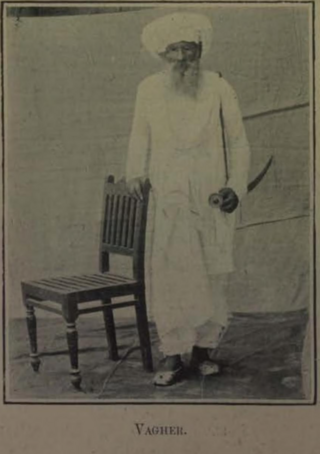
Kutch district, officially spelled Kachchh, is a district of Gujarat state in western India, with its headquarters (capital) at Bhuj. Covering an area of 45,674 km2, it is the largest district of India. The area of Kutch District is larger than the entire area of states like Haryana (44,212 km2) and Kerala (38,863 km2). The population of Kutch is about 2,092,371. It has 10 talukas, 939 villages and 6 municipalities. The Kutch district is home to the Kutchi people who speak the Kutchi language.

Kutchi or Kachhi is an Indo-Aryan language spoken in the Kutch region of India and Sindh region of Pakistan.

Memoni is an Indo-Aryan language spoken by Kathiawari Memons, from the Kathiawar region of Gujarat, India. Memon from Okha Port, Kutch and some other communities from Kathiawad also use Memoni at their homes.
Lohana, also referred to as Loharana, Thakkar, and Barai, are a trading or mercantile jāti. Lohanas claim to be descendants of Lava, son of Rama, and to descend from the Raghuvamsha dynasty. Whereas some claim brahminical lineage in chaurishi gotra Chaurasia community from northern Indian which claim Brahmin lineage from saint chaurishi and have some surnames in common The Lohanas are divided into many separate cultural groups as a result of centuries apart in different regions. Thus there are significant differences between the culture, language, professions and societies of Gujarati Lohanas, Sindhi Lohanas, and Kutchi Lohanas.

The Maldhari is a occupational term or title used by several herdsmen or animal husbandry castes such as Koli, Kathi, Charan, Rabari and Bharwad in Kutch district of Gujarat, India. The Gir Forest National Park is home to around 8,400 Maldharis as of 2007.
Kutchi Memons are an ethnic group or caste from Kutch in Gujarat, India, who speak the Kutchi language. They are related to the Memons associated with the historic state of Kathiawar, a Muslim community of Pakistan and India, who speak the Memon language. Transliteration of name of this Memon community has now been standardized. Hence popular usage is Cutchi and Kutchi.

Nomads are known as a group of communities who travel from place to place for their livelihood. Some are salt traders, fortune-tellers, conjurers, ayurvedic healers, jugglers, acrobats, actors, storytellers, snake charmers, animal doctors, tattooists, grindstone makers, or basketmakers. Some anthropologists have identified about 8 nomadic groups in India, numbering perhaps 1 million people—around 1.2 percent of the country's billion-plus population. Aparna Rao and Michael Casimir estimated that nomads make up around 7% of the population of India.
The term Gujarati Muslim is usually used to signify an Indian Muslim from the state of Gujarat in western coast of India. Most Gujarati Muslims have the Gujarati language as their mother tongue, but some communities have Urdu as their mother tongue. The majority of Gujarati Muslims are Sunni, with a minority of Shi'ite groups.
Nagor or Nagher is a village in Bhuj Taluka of Kutch at a distance of about 8 km from Bhuj town, the capital of Kachchh District of Gujarat in India.
Banni Grasslands Reserve or Banni grasslands form a belt of arid grassland ecosystem on the outer southern edge of the desert of the marshy salt flats of Rann of Kutch in Kutch District, Gujarat State, India. They are known for rich wildlife and biodiversity and are spread across an area of 3,847 square kilometres. They are currently legally protected under the status as a protected or reserve forest in India. Though declared a protected forest more than half a century ago Gujarat state's forest department has recently proposed a special plan to restore and manage this ecosystem in the most efficient way. Wildlife Institute of India (WII) has identified this grassland reserve as one of the last remaining habitats of the cheetah in India and a possible reintroduction site for the species.
The Halaypotra are a Muslim community found in the state of Gujarat in India and a province of Sindh in Pakistan. They are one of a number of communities of Maldhari pastoral nomads found in the Banni region of Kutch.
The Mutwa are a Muslim community found in the state of Gujarat in India and a province of Sindh in Pakistan. They are one of a number of communities of Maldhari pastoral nomads found in the Banni region of Kutch.
The Me Koli also known as Vadha Koli, or Wadha Koli are a partly Muslim Koli and partly Hindu Koli caste found in the state of Daman and Diu and Gujarat in India. They are also known as Maldhari Kolis in the Banni region of Kutch district of Gujarat.
The Manka are a partly Muslim and partly Hindu community found in the state of Gujarat in India.

Wagher, Vagher or Waghir is a jāti from the Saurashtra and Kutch regions of Gujarat in India. Some Waghers are Hindu and others are Muslim. They speak Kutchi as a mother tongue.
The Bafan are a Muslim community found in the state of Gujarat in India and a province of Sindh in Pakistan. They are one of a number of communities of Maldhari pastoral nomads found in the Banni region of Kutch.
The Boricha are a part of the Ahir caste found in the state of Gujarat in India. As descending from Yadav, they are traditionally associated with pastoralism and cattle herding.

Cutch, also spelled Kutch or Kachchh and also historically known as the Kingdom of Kutch, was a kingdom in the Kutch region from 1147 to 1819 and a princely state under British rule from 1819 to 1947. Its territories covered the present day Kutch region of Gujarat north of the Gulf of Kutch. Bordered by Sindh in the north, Cutch State was one of the few princely states with a coastline.
Banni buffalo, which are also known as "Kutchi" or "Kundi", is a breed of buffalo found primarily in the Kutch district of Gujarat, India. The word 'Banni' is specific to not only the buffaloes but as well as the pasture grass species which are native to this region. This breed of buffaloes is usually bred and preserved by a local community found in Kutch, called the 'Maldharis'. An average Banni buffalo yields around 12 to 18 litres of milk each day.

The "Kamangiri art" or Kamangiri bhint chitro is a form of mural painting commissioned primarily in Kutch region of Indian state of Gujarat as well as some regions of Pakistan.








